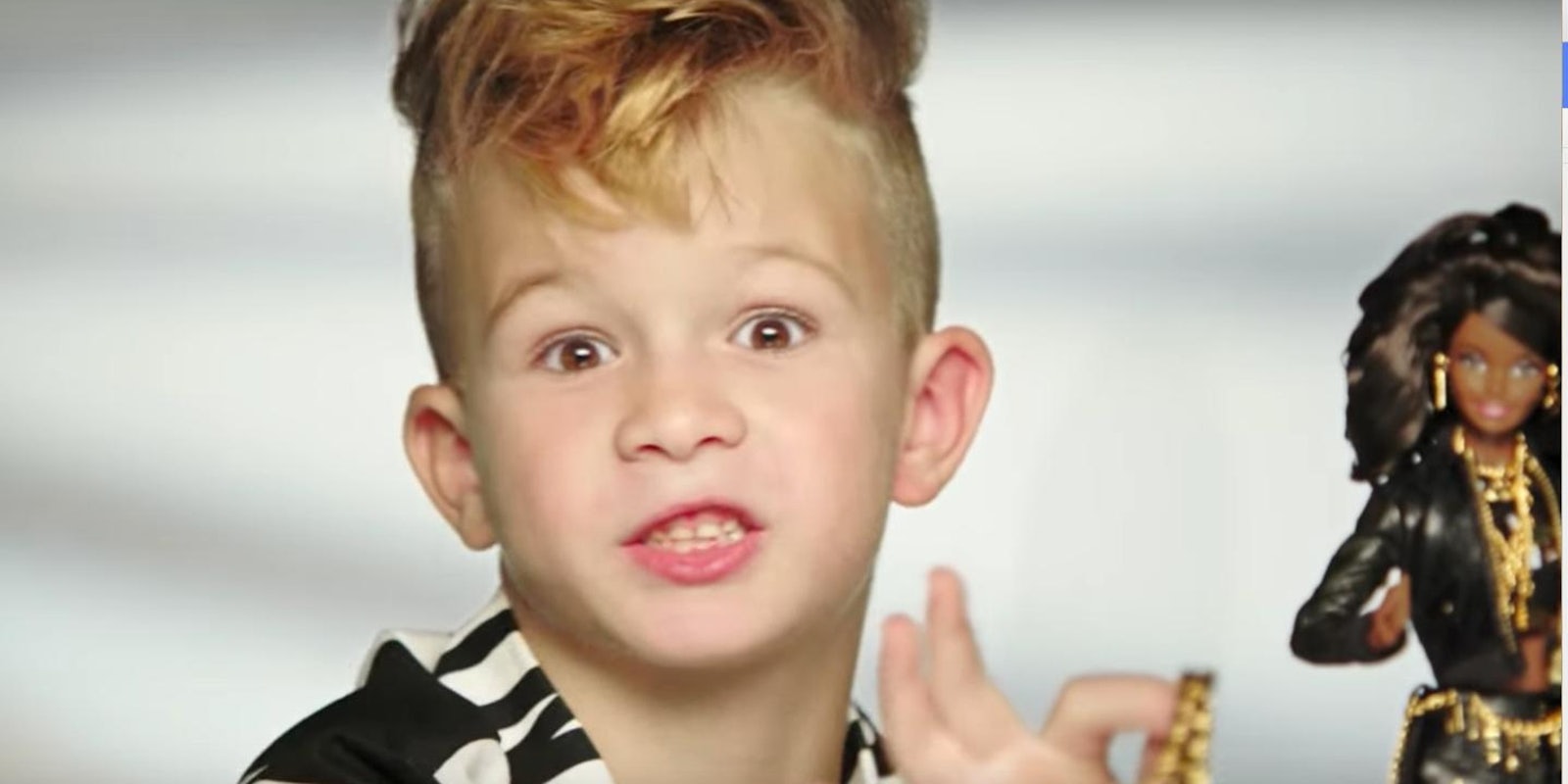The Internet has a problem a new ad campaign from Mattel that features a little boy playing with a Barbie—but not for the reason you might think.
The company is debuting its new fashion-forward Moschino line, and in a video clip that went viral, an impeccably coiffed youngster appreciates the doll’s myriad accessories. “So fierce!” he exclaims. It seems to be a lighthearted homage to Project Runway winner Christian Siriano (who likewise popularized the phrase “hot mess!”), but Twitter users argued that it reinforces lazy stereotypes about gay men.
https://www.youtube.com/watch?v=TULVRlpsNWo
I agree that the character’s over-the-top zebra print wardrobe harkens back to tired notions of male effeminacy, dating all the way back to 1970’s Boys in the Band (often referred to as the Birth of a Nation of gay movies). But what bothers me most about Mattel’s viral bait is how much it misses the point entirely. As someone who was that flamboyant, sassy little boy—and still is—I know that you don’t have to be a future card-carrying queer to want to play with Barbies. Wanting to engage with dolls that break the boundaries of gender has nothing to do with sexual preference; instead, toying with identity and imagination is exactly what kids do. That’s why it’s called playtime.
Playing with Barbies doesn’t make you gay anymore than having G.I. Joes makes you straight.
The war over gendered toys is a battle that’s much older than the Mattel controversy. In the past five decades, toys marketed to American children (and their parents) have been increasingly divided along rigid gender lines. Although half of all toys were gender-neutral back in 1970, today’s stark pink-blue dichotomy separates the dolls from the action figures from the moment a child is born. As the Atlantic’s Elizabeth Sweet found in 2014, the Disney Store website lacks an option to designate toys as suitable for children of both genders; users can choose “Boys” or “Girls”—but absolutely no way not both. (This is still the case.)
According to Purdue professor Judith Elaine Blakemore, the pink-blue dichotomy is just the tip of the iceberg. After conducting research on over 100 different toys, Blakemore told the National Association for the Education of Young Children that she and her team “found that girls’ toys were associated with physical attractiveness, nurturing, and domestic skill, whereas boys’ toys were rated as violent, competitive, exciting, and somewhat dangerous.”
Some retailers—including Target—have decided to buck those trends by refusing to divide up their toy sections by gender, and it’s good to see Mattel getting on board with that movement. But it’s important to recognize why boys might want to play with dolls or other pretty pink playthings. While research shows that kids are coming to terms with their identity at younger ages and coming out earlier, it’s not necessarily a statement about one’s sexuality. Playing with Barbies doesn’t make you gay anymore than having G.I. Joes makes you straight. (I had plenty and clearly that didn’t stick.)
Kids play with toys as a way to both figure out themselves—as the Mattel ad attests—and their environment. One of the most rewarding experiences of my life was getting to watch my baby cousin tinker with his toys when he was barely more than a newborn; what look might look like a feeble attempt to put together Lincoln Logs was actually a deeply interactive process of learning. When he would discover something new—which he didn’t yet have the words to vocalize—you could see it light up in his eyes like another universe created. This is exactly what playtime is: getting to create new worlds within ourselves based on the one outside of us.
Toying with identity and imagination is exactly what kids do. That’s why it’s called playtime.
Playing with Barbies is just another way that both boys and girls can work out real-world concepts with their own hands. While Blakemore warns that Barbies can enforce damaging notions of what women are—Valley Girls and Suzy Homemakers—what drew me to them as a child was that they allowed for sociality. Whereas, say, a Red Ryder air rifle might allow children to pretend to blow things up, playing with dolls is based on communication and imaginative negotiation. To make playing with Barbies fun, they have to talk to each other and have a conversation, one that’s created both by you and by your friends.
Creating such characters and talking through them, whether that’s alone or in a group, can be a profoundly valuable for any child, not just little girls and young pre-gay men. What Mattel should be doing is to encourage all kinds of children to play with Barbies—or any kind of toy that they want. It’s important to let them figure out for themselves what tools will be best for them to use to engage in a process of creative learning; maybe that’s a Barbie doll, maybe it’s a G.I. Joe, maybe it’s a Teddy Ruxpin, or maybe it’s a giant stuffed chicken. Who knows? But these are decisions that shouldn’t be dictated either by gender or crude assumptions about sexuality.
I hope that every flamboyant future queen gets the Barbie he wants. But if his straight brother wants a Stacey doll, we should be willing to let him join in the fun.
Nico Lang is a Meryl Streep enthusiast, critic, and essayist. You can read his work on Salon, Rolling Stone, and the Guardian. He’s also the author of The Young People Who Traverse Dimensions and the co-editor of the best-sellingBOYS anthology series.
Photo via Moschino Barbie/YouTube


